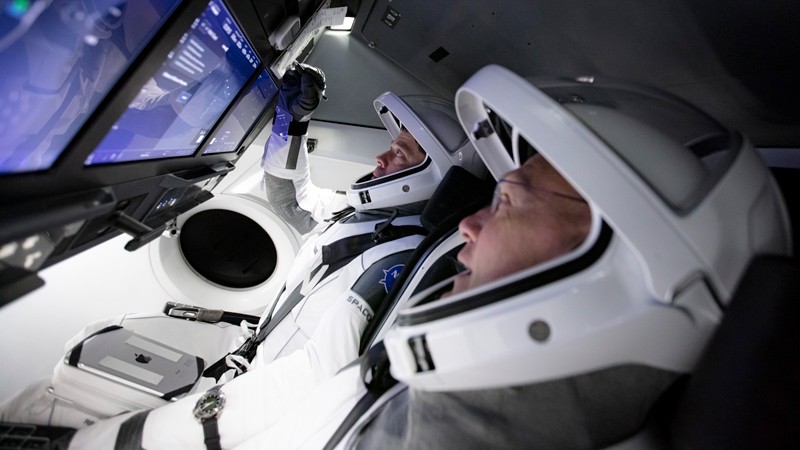On 30 May, tens of millions of space enthusiasts were glued to their screens as SpaceX’s Dragon capsule soared into the air above Cape Canaveral, Florida, aboard a Falcon 9 rocket. The following day, as the capsule docked with the International Space Station (ISS), some 422 kilometres above China’s border with Mongolia, Robert Behnken and Douglas Hurley made history as the first astronauts to ride a commercial craft into orbit.
This development — a decade in the planning — is undoubtedly an achievement for NASA, and for Space X and its reusable rockets. But it is equally a boost for space science and innovation, and especially the enduring value of global cooperation in space research and technology. Amid the jubilation, this aspect of the achievement should be highlighted more.
For NASA, the launch means, among other things, some more money in the bank. Since 2011, when the agency retired the Space Shuttle, NASA has paid Russia up to US$90 million per person to ferry crews to the ISS aboard the Soyuz craft. Seats on the SpaceX capsule are around two-thirds of this cost, which means that NASA can channel the savings into other priorities, including its ambition to return astronauts to the Moon by 2024.
The weekend’s launch also consolidates the position of SpaceX, a company that has mushroomed from start-up to major aerospace player in 18 years. Corporations have been entwined with national space agencies from early on — Grumman (now Northrop Grumman) famously designed and built the lunar module that carried the Apollo astronauts to the Moon’s surface. More recently, other companies have flown humans to space. Virgin Galactic, founded by entrepreneur Richard Branson, has pulled off sub-orbital flights and is planning to offer short trips for passengers to experience a few minutes of weightlessness before returning to Earth. But SpaceX has succeeded at the more ambitious goal of carrying people all the way into orbit.
The company has achieved this through nimbleness, an outstanding team of engineers and product designers, and the determination of its founder, Elon Musk. Musk — who is never far from controversy — has had a hand in disrupting two established industries, first as one of the early developers of online payment systems such as PayPal, and later as chief executive of Tesla, the electric-vehicle manufacturer. But few thought he would succeed when he announced his intention to compete with much larger and more-established corporations in space technology. Arguably, SpaceX’s most important innovation has been to engineer the Falcon rocket so that it can be reused after launch. Once it has jettisoned its payload, the Falcon returns to Earth and lands, vertically, which other rockets do not do.
Although attention is understandably focused on the launch and docking, the reason for the SpaceX mission to the ISS should not be forgotten — the astronauts’ mission is ultimately in the service of science and international research cooperation. Behnken and Hurley will take part in installing a new hardware platform called Bartolomeo, designed by the European Space Agency and Airbus to enable the ISS to host extra science experiments from teams from all over the world.
When big launches grab everyone’s attention, it is hard for research to get a hearing. Earlier this year, two NASA astronauts, Christina Koch and Jessica Meir, completed a challenging upgrade of a fundamental physics experiment on the station, the Cold Atom Laboratory — doing in zero gravity what physicists on Earth might have struggled to do. And, last month, the agency’s Human Research Program announced plans for extended flights to the ISS, designed to simulate the effects on the human body of a journey to Mars.
A global endeavour
It’s unfortunate that those following the weekend’s events did not see or hear much about the ISS’s research contributions, or the fact that astronauts have visited the space station from 19 nations — among them Malaysia, the United Arab Emirates and Kazakhstan. They did, however, see SpaceX and NASA promote the #LaunchAmerica hashtag, and they heard NASA’s Administrator Jim Bridenstine say: “It’s been nine years since we’ve launched American astronauts on American rockets from American soil.”
New space launches — regardless of their country of origin — are often accompanied by a heavy display of national symbols. But it would have been much more powerful, and more uplifting, had the launch also recognized the contributions made by other nations, including Russia, which has been reliably carrying astronauts to the ISS all this time.
From Yuri Gagarin’s orbit of Earth in 1961 to the Moon landings of 1969, space has always been an arena of fierce superpower competition — and newer players, not least China, have since come onto the scene. But, in space research, such competition has not prevented nations from cooperating, and that needs to be recognized and celebrated.
There is plenty of opportunity to do so. SpaceX will make its next run to the ISS as early as August. Bridenstine and Musk should use this next mission to demonstrate that space exploration and research are global. At the very least, they should find a new hashtag — something that will resonate with the millions around the world who watched the weekend’s launch with awe, and will inspire them to join the next generation of researchers, engineers and astronauts.
https://news.google.com/__i/rss/rd/articles/CBMiMmh0dHBzOi8vd3d3Lm5hdHVyZS5jb20vYXJ0aWNsZXMvZDQxNTg2LTAyMC0wMTYyMC0x0gEA?oc=5
2020-06-03 09:03:03Z
52780800879773

Tidak ada komentar:
Posting Komentar